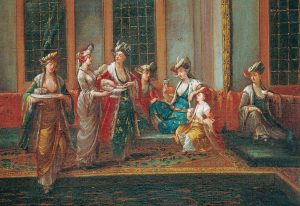
Corvus Greenwood Royal Turkish Jewelry
In keeping with the centuries-old tradition of the Royal Ottoman Court, we offer the following selection of hand-crafted, Sterling Silver and Bronze jewelry, embellished with ruby, emerald, sapphire, amethyst and white topaz gemstones. Our pieces are imported from Europe and bear the .925 Sterling Silver stamp. This is the jewelry to wear when you want to be noticed and make a statement! It is bold, captivating, dazzling and reminiscent of jewelry worn by Royalty. In fact, it reminds us of the jewelry featured on the popular English PBS production, Downton Abby. These one-of-a-kind pieces (no two are alike) make extraordinary, unforgettable gifts. Our exquisite, gemstone-encrusted jewelry honors the Goddess in all her splendor and aids in all ritual work. They are the ultimate, bejeweled amulets for Witch Queens and High Priestesses. Please note: camara flash may cause glare and variations on photos.
Royal Turkish Jewelry
Showing the single result

A brief History of the Royal Jewelry of the Ottoman Court
Turkish Jewelry is documented in court records dating from 1526, when there were 90 jewelry artisans working for the Sultan. This style, referred to as the Jewelry of the Ottoman Court, reached its peak in the 16th century. Gold and semi-precious jewelry was used to decorate not only jewelry, but also other objects such as cups and weapons (such as the dagger, photographed left).
Ottoman jewelry is ornate and colorful, using a variety of metals and giving prominence to the shape and nature of the stones used. For example, rubies, emeralds and other stones are arranged to highlight their natural shapes and characteristics.
Algrettes were used by the Sultan and prominent women of the harem. Horses also wore them during royal ceremonies. (see paintings above.)

Earrings were also popular and have been worn for centuries. With many varied shapes, ranging from small gem drops, to long dangling styles, earrings highlighted the beauty, hair and dress of the Ottoman women. Bracelets were also popular, as were Signet rings, encrusted with gemstones such as rubies, emeralds, carnelian, amethyst and jade. Necklaces worn by women of the Ottoman Court included chokers and long necklaces, decorated with the same motifs and gems as the rings and bracelets. The wealthy women were often identified by the size and splendor of their jewelry.
Stone symbolism
- Rubies: A powerful, intense, activating stone. Draws energy and vitality to the wearer. Bringer of health and joy.
- Emeralds: A favorite stone of Cleopatra. Associated with the planet Venus. Associated with memory, intelligence, kindness, goodness and generousity. Attracts beauty, grace and self-control.
- Sapphires: Blue Sapphires are often associated with witches and is sometimes called the philosopher’s stone. Thought to cast away evil and antidote poison; it attracts the spirits of light, creativity and wisdom.
- Amethyst: Long associated with spiritual power and increasing psychic awareness. Aids in meditation; draws love and inspiration.
- White Topaz: An electric, magnetic stone, associated with powers of regeneration, beauty, intelligence and a long, balanced life.